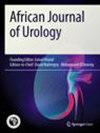Evaluation of sperm DNA fragmentation index among infertile individuals: a comprehensive analysis of the associated factors—a cross-sectional study
IF 0.4
Q4 UROLOGY & NEPHROLOGY
引用次数: 0
Abstract
Ensuring the integrity of sperm DNA is of paramount importance for the production of healthy offspring. The process of sperm formation involves intricate molecular adjustments that condense and safeguard its genetic material. However, the risk posed by sperm DNA fragmentation (SDF) can impede natural and assisted fertility and may arise from various testicular and post-testicular factors. While there are recommendations against routine SDF testing, recent research has sparked debate by demonstrating the positive impact of such testing on fertility outcomes. To identify the factors associated with SDF among infertile individuals. The medical records of infertile men referred to our hospital were comprehensively reviewed and included in the study as they met the inclusion criteria. Patients dissatisfied with participation in the study or those with incomplete medical records were excluded. The association of SDF, sperm analysis, and demographic characteristics were evaluated for further investigation. The average age of participants was 36.1 ± 8.1 years. The average semen volume was 2.5 ± 0.3 cc with a semen pH of 7.4 ± 0.2. The average sperm count was 10.9 ± 0.7 million, sperm motility was 36.9 ± 2.4%, and normal sperm morphology was 41.7 ± 2.7%. SDF levels below 15% were seen in 27.9%, between 15 and 30% in 32.4%, and above 30% in 39.7% of patients. Significant associations were found between the SDF and various factors in sperm analysis, including sperm count (P < 0.001), semen volume (P < 0.001), semen pH (P < 0.001), sperm motility (P < 0.001), normal sperm morphology (P < 0.001), and age (P < 0.001). Moreover, alcohol consumption (P = 0.04), smoking (P = 0.01), and the presence of varicocele (P = 0.03) were significantly associated with. This study emphasizes the significance of SDF among individuals experiencing infertility and investigates its correlation with various sperm test parameters. It also sheds light on the vital roles played by factors such as age, smoking, alcohol consumption, and the presence of varicocele, which are highly likely to cause variations in SDF levels. The results of our research will add to the existing pool of knowledge on infertility and potentially have implications for clinical practice and the care of patients.不育症患者精子 DNA 碎片指数评估:相关因素的综合分析--一项横断面研究
确保精子 DNA 的完整性对于培育健康的后代至关重要。精子的形成过程涉及复杂的分子调整,以凝结和保护其遗传物质。然而,精子DNA碎片(SDF)所带来的风险可能会阻碍自然生育和辅助生育,并可能源于各种睾丸和睾丸后因素。虽然有建议反对进行常规的 SDF 检测,但最近的研究表明这种检测对生育结果有积极影响,从而引发了争论。确定不育症患者中与 SDF 相关的因素。我们全面审查了转诊至本院的不育男性的病历,并将符合纳入标准的患者纳入研究。不满意参与研究或病历不完整的患者被排除在外。研究人员对 SDF、精子分析和人口统计学特征之间的关联进行了评估,以便进一步研究。参与者的平均年龄为(36.1 ± 8.1)岁。平均精液量为 2.5 ± 0.3 cc,精液 pH 值为 7.4 ± 0.2。平均精子数量为 10.9 ± 0.7 百万,精子活力为 36.9 ± 2.4%,正常精子形态为 41.7 ± 2.7%。27.9%的患者 SDF 水平低于 15%,32.4%的患者 SDF 水平介于 15% 和 30% 之间,39.7%的患者 SDF 水平高于 30%。在精子分析中发现,SDF与精子计数(P<0.001)、精液量(P<0.001)、精液pH值(P<0.001)、精子活力(P<0.001)、正常精子形态(P<0.001)和年龄(P<0.001)等各种因素之间存在显著关联。此外,饮酒(P = 0.04)、吸烟(P = 0.01)和精索静脉曲张(P = 0.03)也与精子活力、精子形态正常(P < 0.001)和年龄(P < 0.001)显著相关。本研究强调了 SDF 在不育症患者中的重要性,并调查了其与各种精子测试参数的相关性。它还揭示了年龄、吸烟、饮酒和精索静脉曲张等因素的重要作用,这些因素极有可能导致 SDF 水平的变化。我们的研究结果将丰富现有的不孕不育知识库,并可能对临床实践和患者护理产生影响。
本文章由计算机程序翻译,如有差异,请以英文原文为准。
求助全文
约1分钟内获得全文
求助全文

 求助内容:
求助内容: 应助结果提醒方式:
应助结果提醒方式:


